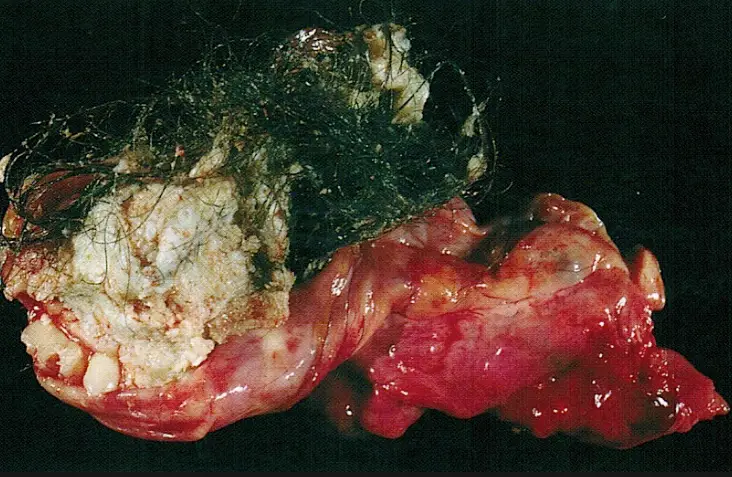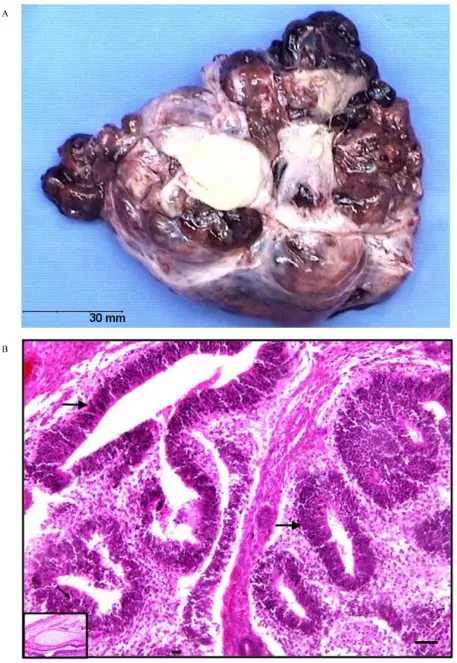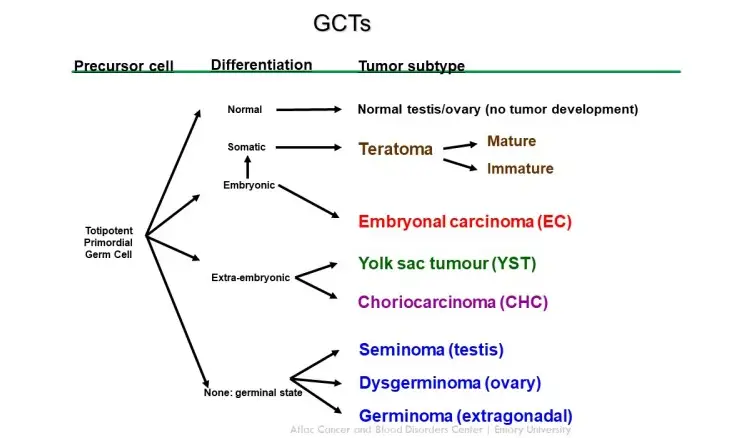Teratomas are fascinating and complex tumors characterized by the presence of tissues from more than one germ layer, often involving diverse components like hair, teeth, or bone. Their uniqueness lies in their composition, which can mirror various body parts, presenting a remarkable study in human developmental biology. While benign teratomas are common, their malignant counterparts pose significant medical challenges.
Mature teratomas are typically benign and composed of fully developed tissues. In contrast, immature teratomas contain undeveloped tissues and are often malignant, requiring different treatment approaches. Understanding the distinction between these types can impact patient management strategies and influence long-term outcomes.
The complexity of teratomas extends beyond their biological makeup to their clinical implications. The presence of a teratoma can lead to a variety of symptoms depending on its location and size, making diagnosis and treatment a nuanced process. As such, medical professionals must be adept at identifying the type of teratoma to provide the most effective care.

Teratoma Basics
Definition and Characteristics
A teratoma is a type of tumor primarily composed of tissues that are more typical of other organs. These tissues can include but are not limited to, skin, hair, teeth, and even more complex structures such as eyes or neural tissue. Teratomas arise from germ cells, which are the cells responsible for giving rise to the human reproductive cells, sperm and eggs. These tumors are intriguing because they have the capability to develop tissues that are unrelated to the area in the body where they are found.
Teratomas are generally categorized based on their content – whether the tissues within are mature or immature – and their nature, benign or malignant. This categorization is critical because it influences the treatment approach and the patient’s prognosis.
How Teratomas Develop
The development of teratomas is linked to germ cells that have become errant in their location or behavior. Normally, germ cells reside in the reproductive organs; however, they can sometimes be misplaced in other parts of the body during early embryonic development. When these misplaced germ cells undergo abnormal growth, a teratoma can form. This can happen:
- During the migration of germ cells in embryonic development
- From retained germ cells that were not incorporated into reproductive tissue
- Through genetic mutations that trigger abnormal cell growth
The exact cause of why these cells start to divide and turn into a teratoma is still not fully understood and is a subject of ongoing research.
Types of Teratomas
Classification Overview
Teratomas are classified based on their location, the maturity of the tissues they contain, and their malignant potential. The main types include:
- Mature teratomas: These are benign and consist of well-differentiated tissues.
- Immature teratomas: These contain undeveloped tissue and have a higher potential to become malignant.
- Specialized teratomas: Including dermoid cysts and struma ovarii, which contain thyroid tissue.
This classification helps in guiding the diagnostic process and the therapeutic management of the condition.
Role in Medical Diagnosis
Identifying the type of teratoma is crucial in medical diagnosis because it affects the treatment plan. Mature teratomas, being benign, often require only surgical removal and periodic monitoring. In contrast, immature teratomas may need aggressive treatment, including surgery, chemotherapy, or radiation, due to their potential to spread and cause harm.
Mature Teratomas
Definition and Features
Mature teratomas are benign tumors that contain well-differentiated tissues, such as skin, fat, muscle, and sometimes fully formed organs or parts of organs. These teratomas are often encapsulated, making them easier to remove surgically.
Common Locations and Symptoms
Mature teratomas are most commonly found in the ovaries in women, testicles in men, and tailbone in children. The symptoms can vary widely based on the tumor’s size and location but may include:
- Pain or discomfort in the area of the teratoma
- Swelling or a palpable mass
- Complications such as torsion, rupture, or infection
Diagnostic Approaches
The diagnosis of mature teratomas involves a combination of imaging studies and biopsy. Common diagnostic tools include:
- Ultrasound: Helpful in visualizing the size and structure of the teratoma.
- CT and MRI scans: Provide detailed images and can help differentiate between mature and immature teratomas.
- Biopsy: Confirms the diagnosis by examining the cell types present in the tumor.

Immature Teratomas
Definition and Characteristics
Immature teratomas are less common and more serious than their mature counterparts. They contain immature, embryonic-like tissues that may lead to malignant behavior. These tumors can grow rapidly and spread to other parts of the body.
Differences in Occurrence and Symptoms
Immature teratomas typically occur in younger patients and are more aggressive. Symptoms are similar to those of mature teratomas but can also include signs of malignancy such as weight loss, fever, or increased markers in blood tests.
Challenges in Diagnosis
Diagnosing immature teratomas is challenging because their symptoms often mimic those of other conditions. Moreover, their aggressive nature means that timely, accurate diagnosis is critical to effective treatment. Techniques used include:
- Detailed imaging studies: To assess the extent of the tumor and any metastasis.
- Biopsy and histological examination: To evaluate the maturity of the tissues present.
- Blood tests: To look for tumor markers that indicate cancer.

Comparative Analysis
Visual and Clinical Differences
Mature and immature teratomas exhibit distinct visual and clinical differences that aid in their diagnosis and management.
- Mature teratomas often appear as well-defined masses on imaging studies, with a heterogeneous internal structure resembling a combination of different tissues. They may contain recognizable structures such as hair, teeth, or bone. Clinically, patients with mature teratomas typically present with localized symptoms related to the compression of nearby structures or organs.
- Immature teratomas, on the other hand, tend to have a more irregular appearance on imaging, with areas of necrosis or hemorrhage indicating rapid growth and aggressive behavior. Clinically, patients with immature teratomas may present with symptoms related to tumor spread or invasion into adjacent tissues.
Impact on Patient Management
The distinction between mature and immature teratomas has a significant impact on patient management.
- For mature teratomas, which are usually benign, surgical resection is often curative. However, careful monitoring is essential to detect any recurrence or malignant transformation. In contrast, immature teratomas require a more aggressive approach, including surgery to remove the primary tumor and chemotherapy to target any residual or metastatic disease.
- Additionally, the long-term follow-up of patients with teratomas is crucial to monitor for late recurrence or the development of secondary malignancies, especially in cases of immature teratomas.
Treatment Strategies
General Treatment Approaches
Treatment strategies for teratomas depend on various factors, including the tumor’s location, size, and histological type.
- Surgery is the mainstay of treatment for both mature and immature teratomas and aims to achieve complete resection of the tumor while preserving organ function.
- Chemotherapy and radiation therapy may be used in cases of immature teratomas or in the presence of metastatic disease to target any remaining cancer cells and reduce the risk of recurrence.
Specifics for Mature Teratomas
For mature teratomas, surgical resection is often curative, with a favorable prognosis. However, careful monitoring is necessary to detect any signs of recurrence or malignant transformation.
- In some cases, fertility-sparing surgery may be possible, especially in young women with ovarian teratomas, to preserve reproductive function.
Specifics for Immature Teratomas
Immature teratomas require a multimodal treatment approach, including surgery and chemotherapy, due to their aggressive nature and potential for metastasis.
- Neoadjuvant chemotherapy may be used to shrink the tumor before surgery, making it more amenable to resection and reducing the risk of tumor spillage or dissemination.
Prognosis Factors
Long-term Outlook for Mature Teratomas
The long-term outlook for patients with mature teratomas is generally excellent, with high cure rates following surgical resection. However, close monitoring is necessary to detect any signs of recurrence or malignant transformation.
- Prognostic factors for mature teratomas include the tumor’s size, location, and histological characteristics, as well as the patient’s age and overall health status.
Long-term Outlook for Immature Teratomas
The prognosis for patients with immature teratomas is less favorable due to their aggressive behavior and higher risk of recurrence.
- Early detection and aggressive treatment are essential to improve outcomes and reduce the risk of metastasis or disease progression.
Factors Influencing Outcomes
Various factors can influence the long-term outcomes of patients with teratomas, including:
- Histological type: Mature teratomas generally have a better prognosis than immature teratomas.
- Extent of disease: The stage of the tumor and whether it has spread to other organs or tissues can impact prognosis.
- Response to treatment: Patients who respond well to surgery and chemotherapy may have better outcomes than those who do not.
- Patient factors: Age, overall health status, and comorbidities can also influence prognosis.
Case Studies
Real-world Examples of Mature Teratomas
Case 1: Ovarian Teratoma in a Young Woman
- Patient: A 25-year-old woman presented with abdominal pain and bloating.
- Imaging: Ultrasound revealed a complex ovarian mass with solid and cystic components.
- Treatment: The patient underwent laparoscopic surgery, and the tumor was removed intact.
- Outcome: Pathology confirmed a mature teratoma, and the patient had an uncomplicated recovery with no signs of recurrence at the one-year follow-up.
Real-world Examples of Immature Teratomas
Case 2: Sacrococcygeal Teratoma in an Infant
- Patient: A newborn infant was found to have a large sacrococcygeal mass at birth.
- Imaging: MRI showed a heterogeneous mass with areas of solid and cystic components.
- Treatment: The patient underwent surgical resection of the tumor followed by chemotherapy.
- Outcome: Pathology revealed an immature teratoma, and the patient required additional chemotherapy due to residual disease. Despite aggressive treatment, the patient experienced disease recurrence and required further intervention.
Lessons Learned from Clinical Practice
These case studies highlight the importance of early detection, accurate diagnosis, and multidisciplinary treatment in managing teratomas effectively.
- Close collaboration between surgeons, oncologists, and pathologists is essential to tailor treatment plans to individual patients’ needs and optimize outcomes.
Frequently Asked Questions
What is a teratoma?
A teratoma is a type of tumor that originates from germ cells and can contain a variety of tissue types, including hair, muscle, and even teeth. These tumors are most commonly found in the ovaries, testicles, and tailbone but can occur elsewhere in the body.
How do mature and immature teratomas differ?
Mature teratomas are generally benign and composed of well-differentiated tissues that resemble normal organs or structures. Immature teratomas, however, are potentially malignant and contain underdeveloped, embryonic-like tissues that can lead to more aggressive behavior and complications.
Can teratomas be cancerous?
Yes, while many teratomas are benign, particularly the mature ones, immature teratomas are considered malignant and can pose serious health risks. Treatment and prognosis depend significantly on the teratoma’s type, location, and the patient’s overall health.
What are the symptoms of a teratoma?
Symptoms of a teratoma vary widely and depend on the tumor’s location and size. Common symptoms include pain, swelling, or discomfort in the affected area. Large teratomas may cause more pronounced symptoms by pressing on nearby organs or structures.
How are teratomas treated?
Treatment for teratomas often involves surgical removal of the tumor. In cases of malignant teratomas, additional treatments such as chemotherapy or radiation may be necessary to manage the disease and prevent recurrence.
Conclusion
Teratomas represent a unique and challenging facet of medical science, bridging complex biological processes with varied clinical presentations. The distinction between mature and immature teratomas is critical, as it influences the therapeutic approach and overall prognosis. Recognizing these differences ensures that patients receive tailored and effective treatment strategies.
Future research into the developmental pathways and molecular mechanisms of teratomas may provide deeper insights into their origins and lead to more targeted therapies. This ongoing study underscores the importance of advancing our understanding to improve diagnostic and treatment options for those affected by these unusual tumors.

